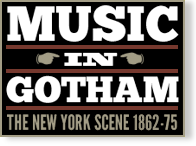Central Park Garden Concert
Event Information
Venue(s):
Central Park Garden
Conductor(s):
Theodore Thomas [see also Thomas Orchestra]
Price: $.50; $1-2, private box
Event Type:
Orchestral
Record Information
Status:
Published
Last Updated:
12 May 2025
Performance Date(s) and Time(s)
28 May 1874, 8:00 PMPerformers and/or Works Performed
Citations
Includes program; Schumann’s symphony was performed in its entirety.
“Since the weather managers have at last pronounced in favor of something like summer—and yesterday was a favorable example of it—the Central Park Garden concerts will now be the chief point of musical interest in the city. Thursday being the principal evening of the week for a programme of more than ordinary attractiveness and classical strength, the beautiful hall and garden were crowded last night. The audience was, in most part, such as might be found at an opera matinée or a first night at Daly’s or Wallack’s, and the marked attention paid to the music was an evidence of the influence wielded by Theodore Thomas and his incomparable orchestra. The first work on the programme was a coronation march by Lux, one of the manufacturers of sweet sounds on the banks of the Rhine, and one whose ‘Ave Maria,’ introduced here by Mr. Thomas, has already acquired popularity. The stately overture, ‘King Stephen,’ by Beethoven, the air from ‘Stradella [Fétis],’ known in Italian as ‘Pieta, Signore,’ very expressively delivered by Mr. C. Cappa on the trombone, and Liszt’s second ‘Hungarian Rhapsody’ preceded the feature of the evening, Symphony No. 4, in D minor, Schumann. This might be called the third of the series of Schumann’s symphonic works, as it was sketched out after the great one dedicated to Oscar I of Sweden. After the success of the ‘Cologne’ symphony Schumann took up the one in D minor, rescored it and made material alterations in it. The movements are so closely linked together that there is scarcely a pause from beginning to end. It was more than a year since Mr. Thomas played it in this city, and its reappearance last night was welcomed with manifestations of extreme pleasure. The beautiful romanza, with its quaint theme, strange to say, strongly resembling a well known Irish air, ‘The Valley Lay Smiling Before Me,’ followed by a tumultuous scherzo and a marchlike finale, was given with that clear, illustrative power so characteristic of this orchestra. Then followed the celebrated bridal music of ‘Lohengrin,’ the lovely meditation of Gounod, which is fast rivalling in popularity the one he wrote on a prelude of Bach; a new waltz by Johann Strauss, ‘At Home,’ not possessing the fire and vitality of his earlier compositions, and the last part of the immortal ‘Tell’ overture. The efficiency of this band has often been commented upon, but one can never tire of admiring the nice balance of tone, power and expression, the hearty spirit with which the players, individually and collectively enter upon a work, the electric fire that flashes forth in such a piece as Liszt’s ‘Hungarian Rhapsody’ and the faultless discipline observable in everything, even to the bowing of the violinists.”
“The principal work on Theodore Thomas’s Thursday programme was Schumann’s 4th symphony, in D minor. It is comparatively fresh to New-York audiences, for though it was formerly played here almost too often, it has been much neglected of late, and we can remember only one performance of it in four or five years. It is numbered as the last of the noble series to which it belongs, but its conception really dates from 1841, for it was written just after the completion of the Symphony in B flat known as No. 1, and the changes afterwards made by the composer before he gave it to the world were in the instrumentation rather than in the ideas. It is one of the strongest and most thoroughly finished, one of the most perfect in form and clearest in expression, among all the works of that reactionary period in Schumann’s life, when he turned away from the romanticism and occasional extravagance of his youth to the severer models of the classical school. The four movements are so closely connected that one seems to flow naturally out of another, and the last three are played without a break. The beautiful Romanza in fact, which stands in place of the customary Andante, is much shorter than an ordinary symphony movement; so too is the charming Scherzo which follows it. Both these gems were delightfully played; but in the long closing Allegro the orchestra seemed fairly to surpass itself, giving one of those magnificent electrical performances which we are half tempted to call inspired. This, however, was by no means the only conspicuously good thing of the evening. Beethoven’s ‘King Stephen’ overture, the ‘Hungarian Rhapsody,’ and the selections from the third Act of ‘Lohengrin’ were also on the programme; Mr. Cappa played the famous Church Aria of Stradella [Fétis] as a trombone solo, with a capital orchestral accompaniment; and besides a variety of lighter pieces there was a rich and brilliant Coronation March in the symphonic style, by Friedrich Lux of Mayence, the same clever musician who made the orchestral arrangement of Schubert’s ‘Ave Maria’ played by the Thomas orchestra. The March, which makes a happy and fresh use of ‘God Save the King,’ won the first prize at an extensive competition in Berlin.”

